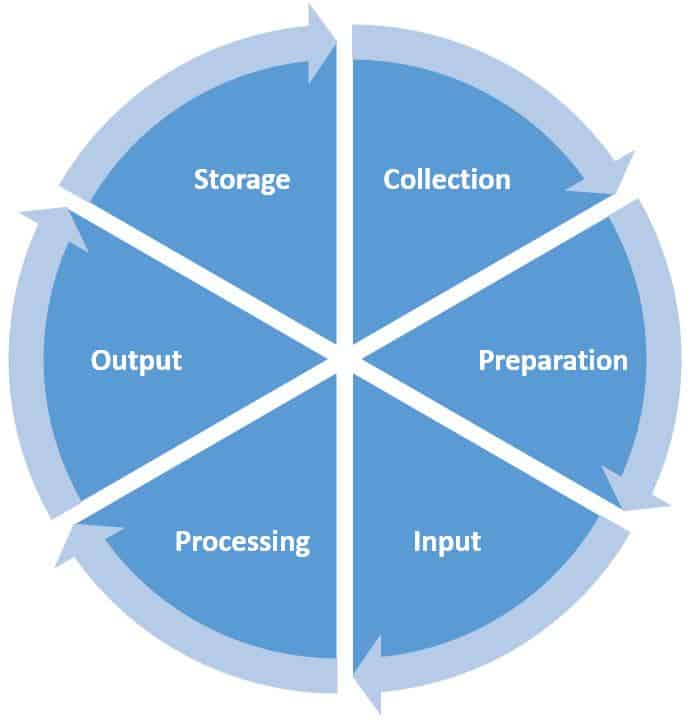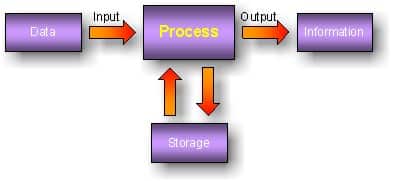All the virtual world is a form of data which is continuously being processed. This processing forms a cycle called data processing cycle and delivered to the user for providing information. “Data” is the next big thing which is set to cause a revolution. The growth of various sectors depends on the availability and processing of data. This continuous use and processing of data follow a cycle. This might provide results instantaneously or take time depending upon the need of processing data. The complexity in the field of data processing is increasing which is creating a need for advanced techniques. Big Data is another big push in this field. All the companies are coming under one roof for data mining, data management and processing it and make their services better!
Read About: Data Processing | Meaning, Definition, Steps, Types and Methods
Related: Data Management Best Practices,
What is a Data Processing Cycle?
Data processing cycle as the term suggests a sequence of steps or operations for processing data, i.e., processing raw data to the usable form. The processing of data can be done by number of data processing methods.
Stages of data processing:
- Input – The raw data after collection needs to be fed in the cycle for processing. This is considered the first step and called input.
- Processing – Once the input is provided the raw data is processed by a suitable or selected processing method. This is the most important step as it provides the processed data in the form of output which will be used further.
- Output – This is the outcome and the raw data provided in the first stage is now “processed” and the data is useful and provides information and no longer called data.
Stages of the Data Processing Cycle
As discussed earlier data processing have three broad stages which have sub stages or steps involved. These are the steps/ process required in between these three broad stages. These deal with the collection of data, choosing the processing methods, practicing data management best practices, information processing cycle, making use of processed data for the desired purpose. Data cycle diagram is presented below. The steps include:
Related: Data Mining, What is Data Mapping, Importance of data processing

- Data Collection: This is the first step which will provide the data for the input. Collecting data is a hard work in its own but is most essential on which the results depend. The quality of input will determine the quality of output. This data collection can be done in various ways by primary or secondary sources. This data might include census data, GDP or other monetary figures, data about a number of industries, profit of a company, etc. Depending upon the data requirement its source must be identified from which data will be collected.
- Preparation/ Sieving: Some people consider this as a part of processing but does not involve any processing. Preparation includes sorting and filtering of data which will finally be used as input. This stage required you to remove the extra or unusable data to make processing faster and better. This is a broad step in reducing the quantity of data to yield a better result.
- Input: This is the feeding of raw and sieved data for processing. If the input is not done properly or done wrong, then the result will be adversely affected. This is because software follows the rule of “Garbage in – garbage out.” Utmost care should be taken to provide the right data.
- Processing: This is the step where data is processed by electronic data processing, mechanical processing or automated means. The processed data is one who gives information to the user and can be put to use. The raw data cannot be understood and thus needs processing which is done in this step. Processing of data may take time depending on the complexity of the data and the volume of input data. The step of preparation mentioned above helps in making this process faster.
- Output/ Result – This is the last step of the data processing cycle as the processed data is delivered in the form of information/results in this step. Once the result or output is received, it may further be processed or interpreted. This is done by the user or software for further value addition. This output can also be used directly in presentations or the records. This output may even be saved as to be used as an input for further data processing which then becomes a part of a cycle which is being discussed. If this data is not used as input, then this complete process cannot be considered as cycle and will remain to be a one-time activity of data processing. For using this data as input, it must be stored or simultaneously be available for further processing.

All these steps or stages have a particular sequence which must be followed. If processing is done manually as the automatic processing have inbuilt algorithms with predefined steps. In automatic processing, the chances of error are drastically reduced. This happens only when the input is a correct data or data set.
Related: Data Processing Methods, Information Processing Cycle, Data Visualization
Most of the programs which process data completely or partially have a back-end with a pre-defined algorithm and sets of operation. A single software is performing all the required steps is considered to have a complete data processing cycle in its back-end. A combination of a different set of hardware and software is needed to complete the cycle in partial data processing. It becomes the responsibility of the person operating this set to feed and receive the output in a particular sequence.
Limitations of the data processing cycle (what not to expect)
Data cycle in most of the cases is a complete cycle in itself. But as mentioned above a set of hardware and software might also be employed in some cases with special needs. In such cases, some things need to be taken care of to get the sensible and useful output. This depends on the correct sequence, operating skills, understanding of the steps forming the cycle. Partial output from one part which will be used as an input for next part. If a person/operator/machine or software fails to perform the steps in sequence than the output will not be useful.
Tags: Data Processing Cycle, Processing Cycle, Stages of Data Processing, Data Processing Stages, data cycle, data processing in computer, 4 stages of data processing, computer cycle
Read about: Types of data processing, Data Presentation & Analysis
It is really good source thank so much